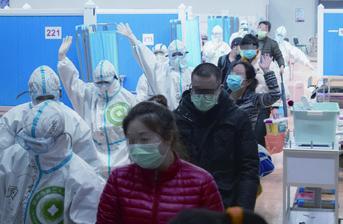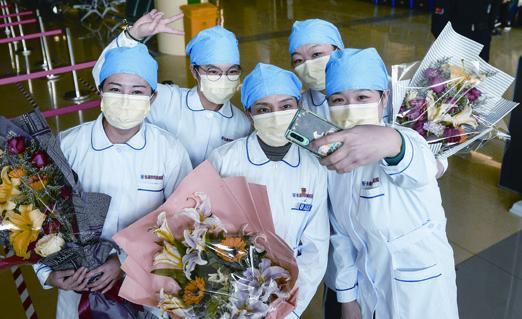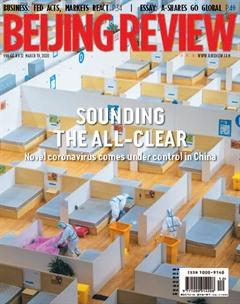Turning the Tide
By Ji Jing
The Wuchang Hospital, which was converted from a stadium in Wuhan in Hubei Province, was closed down on March 10 after seeing off its last 49 patients. It is the last of the 16 temporary hospitals in the city to close.
The retirement of such hospitals, as sudden as their emergence in the past 35 days, marks a milestone in the war against the novel coronavirus disease 2019(COVID-19).
The spread of the novel coronavirus has been basically curbed in Hubei including Wuhan. “Initial success has been achieved in stabilizing the situation and turning the tide,” President Xi Jinping said on March 10 during a visit to the city.
Meeting a pressing need
When the novel coronavirus outbreak was first detected in Wuhan in January, Chen Xiaoguo, a nurse at the Fourth Peoples Hospital in the city, worked at least 10 hours a day with other medical workers as the number of patients surged. She witnessed firsthand the acute shortage of hospital beds at that time. Every day, there was a long queue of anxious people waiting at the entrance hall of the hospital from dawn to dusk.
On January 31, the 23 hospitals in the city designated to treat COVID-19 had around 6,600 beds altogether but it became inadequate as the number of confi rmed cases soared.
In the beginning, the municipal authorities asked both confirmed and suspected patients as well as their close contacts to quarantine themselves at home. But the measure was ineffective due to inadequate protective measures at home, this often led to the infection spreading among family members.
Wang Chen, Vice President of the Chinese Academy of Engineering, who went to Wuhan with the central government working group guiding novel coronavirus epidemic control in Hubei, proposed converting available public facilities into hospitals.

In early February, the first three converted hospitals, which had a total of 3,400 beds, started admitting patients. Chen told National Business Daily that on learning this, she cried with relief. She knew the worst days were over. Ten days later, there were no more jostling crowds in her hospital. Converting public buildings into temporary hospitals to cope with the rising flow of patients in Wuhan, where the epidemic has created the maximum havoc, was a turning point in the fi ght against the virus.
During the peak of the epidemic, over 3,000 people needed to be hospitalized every day, which would be a challenge for any city in the world. Wuhan had only two infectious disease hospitals with no more than 1,000 beds, Ding Xiangyang, Deputy Secretary General of the State Council, Chinas cabinet, said. It coped by setting up 86 designated hospitals for COVID-19 patients and converting public facilities into 16 temporary hospitals, thereby creating over 60,000 beds, tantamount to 60 large hospitals.
After the fi rst three converted hospitals started treating patients in early February, the epidemic prevention and control work became orderly. The 16 converted hospitals combined had over 13,000 beds, and treated around 12,000 patients, one in four of all COVID-19 patients in the city, Ma Xiaowei, head of the National Health Commission (NHC), said at a press conference on February 28.
Now epidemic prevention and control measures have produced tremendous results. In February there were over 1,000 confi rmed cases in Wuhan every day. Now the number has been reduced dramatically. On March 11, the city reported eight new confirmed cases and two new suspected ones.
As of March 11, there were 80,793 confi rmed cases on the Chinese mainland. While 62,793 people had been cured, the death toll was 3,169. Besides Wuhan, other cities and prefectures in Hubei had reported no new cases for seven consecutive days. On that day, 15 new cases of confi rmed infections and 33 new cases of suspected infections were reported on the Chinese mainland.
Coordinated work
Ding attributed the progress to coordinated efforts across the country. The Central Government guided epidemic prevention work and the local governments followed the lead, he said at a press conference in Wuhan on March 6.

In the beginning medical materials were in shortage in Hubei. But factories across the country resumed production and expanded their output to contribute to the anti-epidemic efforts.
The daily output of protective suits has increased from less than 20,000 to around 500,000; about 1.6 million N95 respirators are being produced daily, up from 20,000; and 100 million ordinary masks are produced daily, Wang Jiangping, Vice Minister of Industry and Information Technology, said at a press conference on March 6. He is also a member of the central working group guiding novel coronavirus epidemic control in Hubei.
By March 5, 12 enterprises had been licensed to make test kits. Now there are around 2 million test kits in stock, he said.
World Health Organization Director General Tedros Adhanom Ghebreyesus has asked manufacturers worldwide to increase the supply of protective materials to combat the epidemic.
“Since the epidemic is coming under control in China, China will provide support to other countries in need of protec- tive materials,” Wang Jiangping said. “We encourage protective material, medical equipment and pharmaceutical enterprises to meet demands from abroad to contribute to the global fi ght against the virus.”
Greater safety
At first, owing to inadequate understanding of the virus and lack of epidemic prevention knowledge, over 3,000 medical workers were infected in Hubei.
Ding said a technical guideline for medical workers has been drafted to ensure their safety. They will henceforth receive training on preventing infection before going to the frontline. Besides, medical workers are now working in shifts. As a result of all these measures, hospitalacquired infection is under control.
“None of the over 40,000 medical personnel sent to Hubei has been infected,”Ding said.
Scientists are still engaged in research to strengthen epidemic prevention and treatment. The new vaccines can be put on clinical trial by mid-April or even earlier. New methods for treating the disease have proved effective. Blood plasma collected from people who recovered from COVID-19 and stem cell treatment have proved to be effective for treating critically ill patients.
Yu Yanhong, deputy head of the National Administration of Traditional Chinese Medicine, said combined Chinese and Western medicine treatment has proved effective in treating COVID-19 patients. Most of the patients who have been cured received combined Chinese and Western medicine treatment.
By March 3, 14 kinds of test kits had entered the market after emergency review and approval.
However although the situation in Wuhan is under control, the remaining confi rmed and suspected cases in the city still constitute a large number. The pressure of treating patients is still huge in Wuhan, which remains a key area of the national epidemic control, Ding said.

